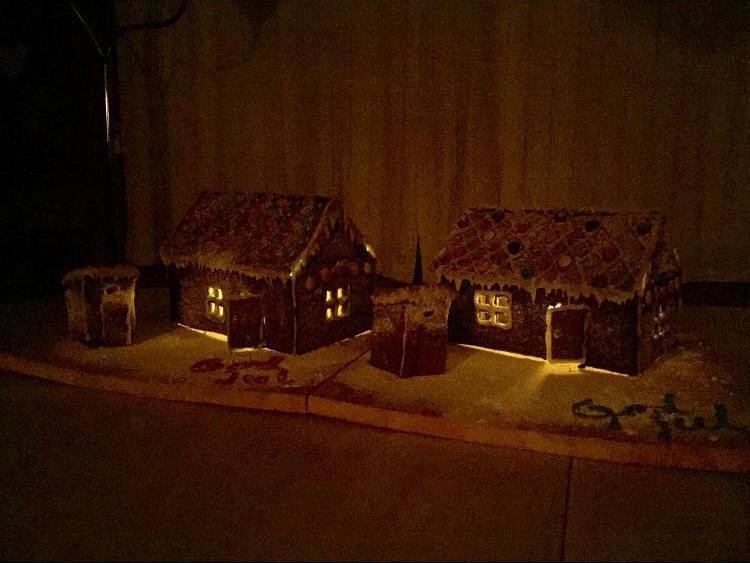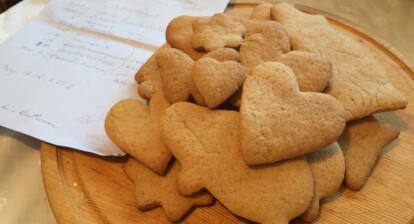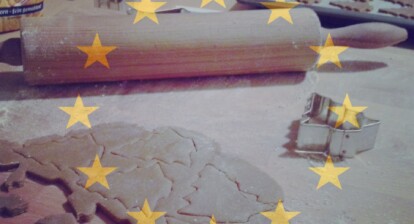Is there a better wrap up of the year than a very special memory suitcase filled with heartwarming holiday stories and recipes? If you are looking for the Christmas recipes to make your holiday sparkle we got you covered with with some traditional sweet treats and a special salty “lucky” recipe. You only need to roll up the sleeves and test your baking skills!
Terrace Stairs to Heaven: Best Cookies Come Last
by Trixi, Germany
Trixi from Germany is celebrating Christmas at home in Münster, enjoying the time with her family. “On the first Sunday in December we start off the Christmas season with a cookie-baking-marathon. All of the cookies are original recipes from my grandmother. We still have the old book where she wrote all her recipes down. By now my mum knows the ingredients for our favorite cookie by heart. Since we only have one day to bake all the delicious cookies we make the doughs the day before and then start early next morning right after breakfast. Usually all four of us, my parents, my sister and me are baking together, but when listening for the third time the Michael Bublé Christmas album, my dad escapes out of the kitchen and starts eating the fresh cookies instead of helping us. The terraces are the favorite cookie of all four of us, that’s why we bake them last, so we don’t dare eating them all day long with nothing but leftovers at the end of the day. However, would it really be that terrible eating all of them? We would just have to bake more of them soon!
Ingredients for “Terrassen” (engl. terraces)
|
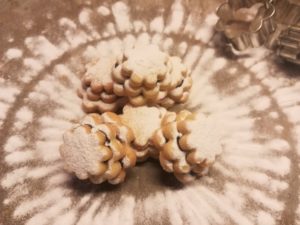 Terrassen with snow! (Photo: Private) |
Preparation
Mix and knead all the ingredients together and let the dough rest for some time in the fridge (the best to do is to let the dough stay in the fridge overnight and start the baking fun on the next day). Roll out small bits of the dough one by one really flat and thin (the first round of rolling might be very difficult because the dough is still very hard and cold because of its residence in your fridge, but don’t try to warm it up, it’s getting better by the next round, I promise!).Now you need three similar shapes of cutters but in different sizes (one small, medium and large cutter) and cut out the same number of cookies of each size.Bake the cookies for around seven minutes by 180° in the oven. When they are still hot, put one of each size on top of each other and glue them together with currant-jelly. You will get around 42 cookies. When they are cooled down sprinkle them with some powdered sugar so it looks as if there was snow on top of them.
Traditional Honey Cookies for a Honey Christmas and a Sweet New Year
by Fotini, Greece

Lot’s of Melomakarona. (Photo Private)
Over the last twelve years, Fotini from Thessaloniki has been working at her aunt’s tiny and sweet toy store the weeks before Christmas, hoping to contribute to a playful and cheerful Christmas time for children and their families: “The long working hours, though exhausting, are fulfilling, but they also make us extremely hungry. So, to fill the toy store with Christmas scents and aromas, we bring the most delicious Christmas cookies to the store, following the tradition and recipe of Grandma Anna.
Two weeks before Christmas we gather together: Grandma, children and grandchildren- and we bake together the all-time classic Greek Christmas sweet treats, called ‘Melomakarona’. The name ‘Melomakarona’ comes from two words: ‘meli’, meaning honey and ‘makaria’, a word used during the Middle Ages to describe a special kind of bread. As their name reveal, what makes them so special is the honey used to sweeten them, an ingredient which in the Greek tradition symbolizes well-being, life and creation. Baking them with the family and offering them to our beloved ones and to the people that come to the toy store around Christmas time, is for us a way to come together, celebrate Christmas and wish to everyone a healthy and sweet like ‘meli’ new year.“
Ingredients for Melomakarona (engl. honey bread)
- 500 ml water
- 600 grams sugar
- 4 cinnamon sticks + 4 teaspoons cinnamon
- 4 cloves + ½ teaspoon cloves
- 1 orange, 400 grams of orange juice + zest of two oranges
- 350 grams honey
- 560g seed oil
- 50g icing sugar
- ¼ teaspoon nutmeg
- 1 teaspoon baking soda
- 1kg all-purpose wheat flour
- 200g semolina flour
- extra honey and chopped walnuts or melted chocolate for drizzle
Preparation
First, you need to prepare the syrup, in order to let it cold. Heat half a liter water, 600g sugar, 4 sticks of cinnamon, 4 cloves and an orange cut in half for 2 minutes (till the sugar melts). In the end add 350g honey and mix. Let the syrup cool down. Mix 400g orange juice, 560g seed oil, 50g icing sugar, ½ teaspoon cloves, 4 teaspoons cinnamon, ¼ teaspoon nutmeg, 1 teaspoon baking soda and the zest of two oranges in a bowl. Then add 1kg of wheat flour and 200g semolina flour. Mix only by hand very gently for a very short time and then mold the dough into oval-shaped cookies. Bake for 25 minutes at 180oC (fan function). As long as you remove the hot cookies from the oven soak them for 10 seconds in the cold syrup, drain them well and drizzle them with extra honey and chopped walnuts. You can also cover them with melted chocolate for a twist. Enjoy with friends and family!
Easy and tasty: Cocoa Balls With a History
by Jakob, Denmark
Jakobs recipe from Denmark is a real treat and it’s easy and fast to make. It’s called “Havregrynskugler” which would roughly translate to oat cocoa balls. The recipe originates from World War II and it is mostly made at Christmas time “In my family we tend to make some sweets close to Christmas and it’s always fun to make themand save them for Christmas Day. It’s kind of a tradition we do each year, and it originates from when my siblings and I were children.”To make one portion of “Havregrynskugler” you’ll need:
Ingredients
- 175 grams of rolled oats
- 100 grams powdered sugar or normal sugar
- apx. 25 grams Cocoa powder
- 100 grams softened butter
- 2 tablespoons or slightly more coffee/water or juice
- some Coconut Flower
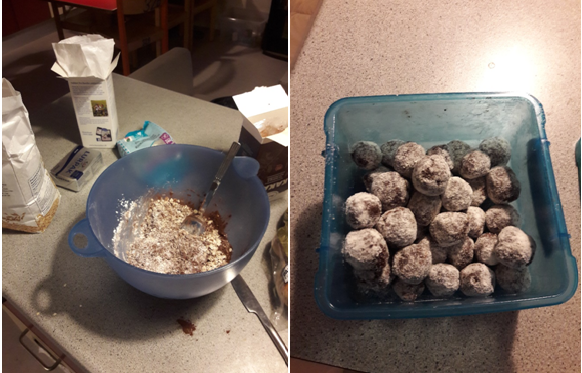
Ready, steady – go! Your Cocoa balls. (Photo: Private)
Preparation
First you mix all the dry ingredients together in a bowl. Then you stir the butter in the mix to mold it into a brown looking mass. Then add some of the fluid and mold it again. Create small round ball looking pieces and then roll them in the coconut. After you’re done, put them in the fridge. Then voilá! Enjoy some nice tasty Havregrynskugler. Merry Christmas from Denmark!
The One and Only Christmas Sweet for my Family: Pestiños
by Miguel, Spain
Making “pestiños”for Christmas has been a family thing for many years in Miguel’s family. All the grandchildren used to help making them, by chopping of the walnuts or shaping them. The feeling of all the family sharing laughs and a good time together is lots of fun and one of his dearest memories of Christmas:”This is a traditional recipe of my grandmother; she used to prepare Pestiños every Christmas. Once she hurt herself and couldn´t do it, my grandfather learnt from her how to do it, and kept on the tradition. Eventually he even taught me how to do it, basically this is a common recipe but with much more ingredients and care. Making these ones for the article has been very special because my grandfather passed away last year and it has been the first time making them just on my own. It has been hard and a bit sad but the feeling of getting to do it and make the ‘pestiños’ taste well has been incredible. My grandfather taught me well and I will teach you too.”
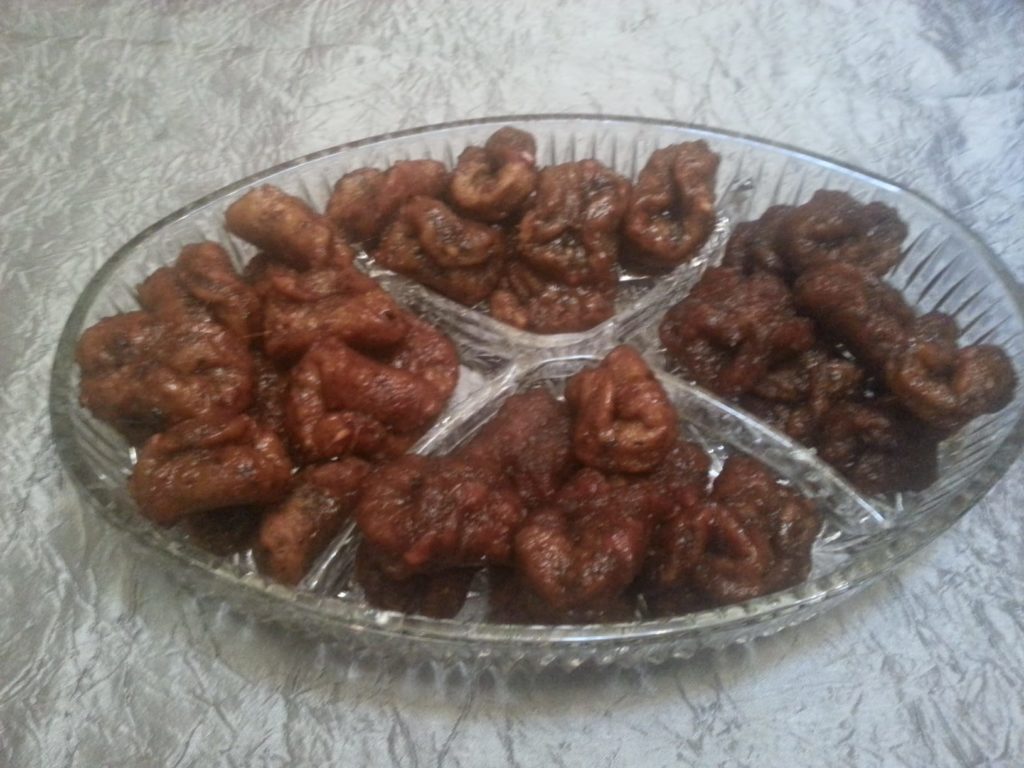
This is how Miguels Pestiños look once prepared! (Photo: Private)
Ingredients for Pestiños
- 500 grams of white flour
- 500 ml of olive oil (in two glasses of 250 ml)
- 500 grams of honey
- 1 lemon
- 1 orange
- 250 ml of white wine
- 150 grams of anise seeds
- 150 grams of clove
- 150 grams of almonds
- 150 grams of walnuts
Preparation
First of all, you have to prepare de ingredients. Chop the walnuts and almonds to very little pieces. Grind the clove until making it dusty like. Peel of the lemon and orange, put the peels aside, you will use it later.In a medium hot pan with little oil roast the grinned clove and the chopped walnuts/almonds. Do it until it has a nice golden color (also you will know it because it will start smelling really good!). Then get it off the heat so it doesn’t burn.While the mix cools off a little, pour one of the glasses of oil in a pan at a medium-high heat. When it is heated, fry up the peels of the orange and the lemon. Once they are well-fried (so the oil has a nice fruity taste to it) throw away the fried peels and get the oil out of the heat.
Once it has cooled off for a couple minutes (not longer, we need the oil to still be warm) add in the toasted almonds, walnuts and clove. Also, the anise seeds, since they are so small, they well fry themselves with the heat that the oil still has. Let the oil absorb the taste of everything of 3-5 minutes.Prepare a huge bowl or a clean table and put the flour. Then pour in the oil with all the mix (if it is still hot it will be easier to make the dough) and also the white wine. Mix it very well until you have a nice dough (add more flour if it is very soft or more wine if it is very dry) that doesn’t stick to your hands or the bowl/table. Let the dough rest for 2-3 hours in a fresh and dry place.
Start working with the dough making little thin circles. For that just smash the dough with a rolling pin and make the shape with a small glass. The traditional shape of the pestiños is kind of folded in itself. For that just get one end of the circle and bend it to the center, do the same with the other end but over the first one. Apply pressure so it doesn’t open while frying it. Once you have made all the pestiños fry them at medium heat (so it cooks well both on the inside and outside) in several batches, because if the oil cools off the will start dissolving.
Put the honey in a pan at medium heat, close to the one where you are frying the pestiños. Once every batch is properly fried up, immediately immerse them in the warm honey. Let them stay there for 4-5 minutes while you keep moving them so they do not stick up (in these step the help of another person is much need, because it is easier if one person is frying them and the other is immersing them in honey). After that time just put them in a nice bowl and let them cool off. Once you are done with all the pestiños, pour some extra honey on top of them.
Suggestion: Let them stay for a day so they soak the honey for them to be extra good!
From Small House to Eiffel Tower: Christmas fun with Gingerbread
by Ingvild, Norway
Ingvild celebrates Christmas together with her closest family on their farm. Ever since she was a child, her family and some family friends have gathered in the advent time to make gingerbread houses together. “We always divided into two groups, and we always had a competition that we took really seriously. The first couple of years, we built simple and normal houses, but eventually, we became better and more ambitious, and built boats, rockets, the Golden Bridge and the Eiffel Tower.” The pictures show two houses Ingvild built outside of the competition, both a simple house from Christmas 2018, and a China-inspired house from 2017. This recipe fits a small house, but if you want to build something bigger, just multiply it. Just remember that it takes a lot more time to build something big and advanced, and it can be just as fun to make something small and easy, because then you have more time to decorate the house nicely.
Ingredients for Norwegian gingerbread
- 50 grams sugar
- 150 ml. water
- 75 ml. syrup
- 1 teaspoon of cinnamon
- 1 teaspoon of cloves
- 1 teaspoon ginger
- 250 grams of butter
- 1 tablespoon baking soda
- 800 grams of wheat flour
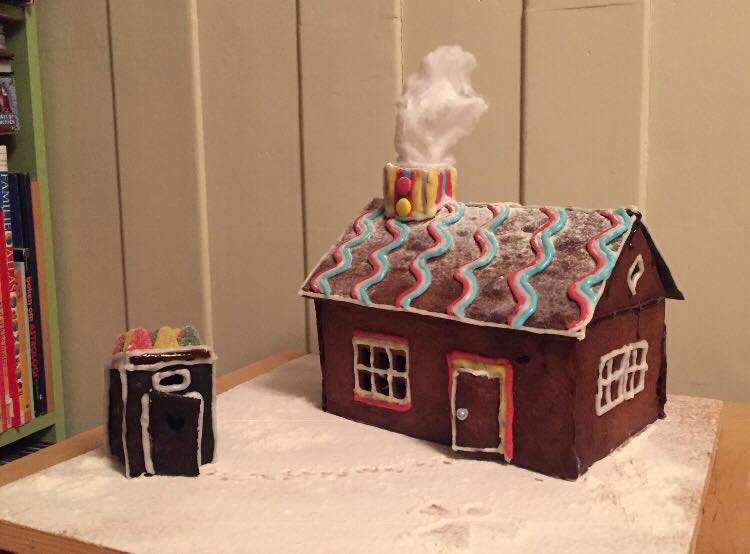
I built a Gingerbread house together with a … (Photo: Private)
Preparation
Mix sugar, water, syrup, cinnamon, cloves and ginger in a saucepan and heat to the boiling point. Remove the pan from the plate and add butter divided into cubes. Stir until it gets cold. Add flour and baking soda. Quickly work the dough together and leave it in the fridge for two hours or overnight before rolling it out. Preheat the oven to 170 degrees Celsius. Now, you have to decide how big and complicate you want your house. One of the easiest ways is to decide how long, wide and high you want it, and make six squares that fits to this. Make windows, doors, a pipe and other details if you want. It’s best to roll out the dough on a baking sheet. Roll it thicker than you do when making plain gingerbread, it should be about 0.5 centimeters thick. Fry the gingerbread house parts on the middle rack in the oven for 15 minutes.Allow to cool completely before mounting the housing. The gingerbread house parts are still soft when they come out of the oven, so make sure they lie completely flat when cooled. The gingerbread house is glued together by making melted sugar. The sugar gets very hot, so here the job should be done by an adult. It is advisable to mount the gingerbread house on a tray or foil, so it will be easier to move it around after it is finished.
Special New Year Recipe – Bulgarian “Lucky” banitsa
by Momchil, Bulgaria
On New Year’s Eve, 10 days after the 40 days of fasting, Bulgarians prepare Banitsa:”During the process of preparing we divide it into several pieces and put a small pieces of paper with written: ‘късмет’–‘a luck’ or ‘a chance’ in each of them. The ‘lucks’ include things such as ‘Good health’, ‘Love’, ‘Money’ and so on. There is always one piece with a coin in it. When the eve comes and everyone sits on the table, each person picks a piece the Banitsa and checks what ‘luck’ he has. The one who picks the piece with the coin is said to be the luckiest one. After this everyone should eat his or her piece of Banitsa, so to get his or her ‘luck’ ‘activated’.”
Ingredients for banitza
- 12 sheets filo dough
- 8 tablespoons butter
- 250 grams sirene (Bulgarian cheese) or feta, coarsely crumbled
- 350 grams Bulgarian yogurt (preferably sheep’s milk yogurt)
- 4 whole eggs
- 1 egg yolk
- salt
- pepper
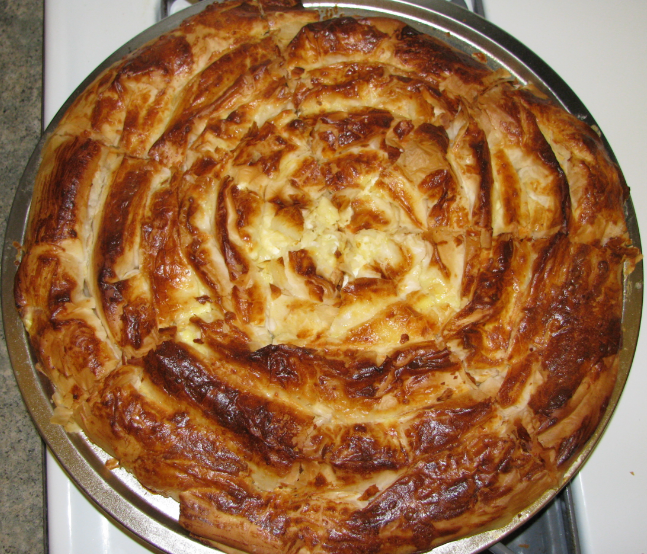
Christmas is over? Go for a New Year Banitza! (Photo: Private)
Preparation
Whisk yogurt with four whole eggs. Add cheese, salt and pepper and mix. Melt the butter.Take two sheets of filo and brush the top sheet with melted butter. Superimpose a third sheet on the first two and brush the top with butter. Turn the three sheets over and then brush the non-coated side. Divide ¼ of the yogurt, egg and cheese mixture on top of the filo sheets. Then roll the whole preparation like a long sausage. Roll lengthwise to get the roll as long as possible. Repeat this process three more times to get four long rolls of three superimposed sheets of filo each.Place the spring form pan on a baking sheet (or just circle on baking sheet covered with parchment paper). Begin by placing the first roll by sticking to the edge of the circle, then add the following forming a snail to the center. Beat egg yolk with the remaining melted butter and brush the whole Banitsa. Bake at 200°C for about 25 minutes. The Banitsa should be golden. It can be eaten either hot, warm or cold.
If this is not enough we have some more European recipies for you! The collection offers some from Israel, Finland, Serbia, France, Italy and many more – just have a look:
Please enjoy and share impressions from your baking results!

